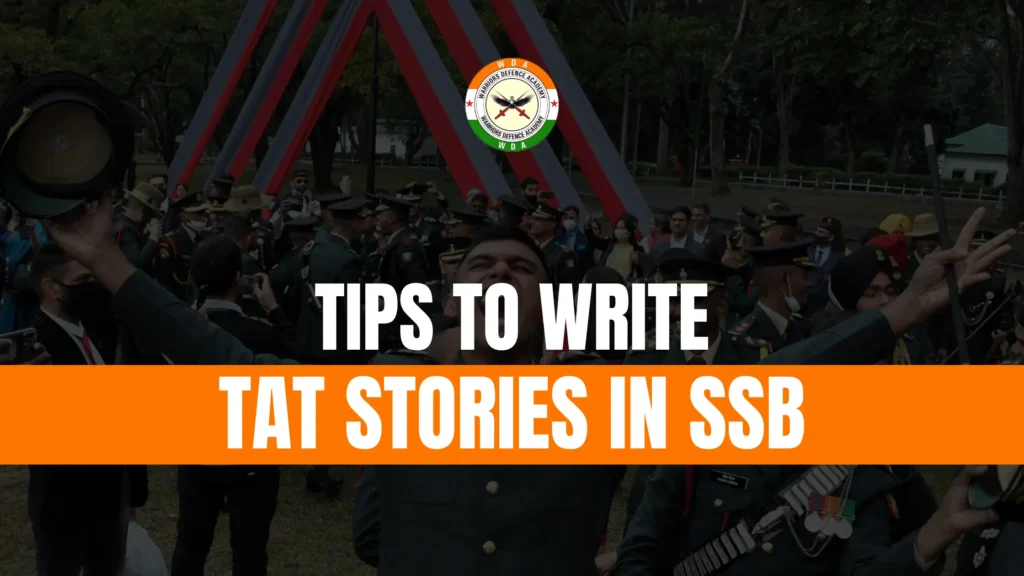Tips for Writing TAT Stories in SSB: Understanding how to write TAT stories in SSB Interview is very important for candidates who want to join the Indian Armed Forces. It helps them communicate well, show leadership, and solve problems quickly during the test.
This guide offers comprehensive advice on creating compelling TAT narratives, covering crucial aspects such as interpreting the picture, structuring the storyline, and highlighting positive attributes. By adhering to these guidelines, candidates can enhance their performance in the TAT, leaving a lasting impression on assessors and boosting their prospects in the SSB interview. The objective of this article is to dispel uncertainties and empower candidates with the essential tools to excel in this pivotal component of the selection process.
TAT Stories In SSB
Thematic Apperception Test (TAT) forms a crucial part of the Psychological Tests administered during Services Selection Board (SSB) interviews for candidates aspiring to join the Indian Armed Forces. TAT assesses candidates’ creativity, perceptiveness, and their capacity to respond to diverse life scenarios. During this test, candidates view ambiguous pictures and must promptly construct a story based on each image. These narratives serve to illuminate the candidate’s cognitive processes, leadership traits, problem-solving abilities, and overall character.
Tips for Crafting Effective TAT Stories in SSB
Writing compelling TAT stories requires a mix of creativity, clarity, and structure. Here are essential tips to help you excel:
- Interpret the Picture: Take a moment to thoroughly observe the picture before you begin writing. Identify key elements, setting, and emotions conveyed to create a relevant and coherent story.
- Develop a Positive Plot: Construct a story with a positive and constructive plot. Focus on themes like problem-solving, teamwork, leadership, and perseverance. Avoid negative or destructive themes that may reflect poorly on your character.
- Structure Your Narrative: Ensure your story has a clear beginning, middle, and end. Introduce characters and setting at the start, develop the plot in the middle, and provide a resolution by the end. This structure aids clarity and understanding.
- Highlight Leadership and Problem-Solving: Showcase your leadership and problem-solving skills through your protagonist. Demonstrate initiative, decision-making ability, and the capacity to lead others effectively, showcasing your suitability for military roles.
- Embrace Originality: Aim for original and creative storytelling. Avoid clichés and refrain from borrowing stories. Authenticity is key to making a strong impression.
- Maintain Realism: Craft stories that are realistic and believable. Avoid overly dramatic or implausible scenarios. Assessors seek practical, sensible solutions to real-life situations.
- Practice Time Management: Given the limited time (typically 3-4 minutes per story), practice writing within this timeframe to improve speed and efficiency. Clear articulation under time pressure is crucial.
- Use Clear Language: Write using simple and clear language. Avoid complex vocabulary and convoluted sentences to ensure effective communication of your ideas.
- Reflect Positive Emotions: Infuse positive emotions such as hope, determination, and empathy into your stories. Engaging narratives reflect optimistic and resilient personality traits.
- Seek Feedback: Review your stories critically and seek feedback from mentors or peers. Use feedback to identify areas for improvement and continuously enhance your storytelling skills.
Mastering TAT storytelling enhances your ability to communicate effectively, demonstrate leadership, Developing the skill to write effective TAT stories in SSB requires practice and meticulousness. By interpreting the picture, constructing positive and constructive plots, and highlighting your leadership and problem-solving prowess, you can create compelling narratives that demonstrate your readiness for a military career. It’s essential to maintain originality, realism, and clarity in your writing, continually striving for improvement through practice and feedback. These strategies will elevate your performance in the TAT and enhance your prospects for success in the SSB interview.
Also Read: How to Write PPDT Story in SSB Interview?
FAQs Related to Tips To Write TAT Stories In SSB
Q1. What is the Thematic Apperception Test (TAT) in SSB?
Ans: The Thematic Apperception Test (TAT) in the SSB interview is a psychological assessment where candidates interpret ambiguous pictures by writing stories. This test aims to unveil candidates’ creativity, leadership qualities, and problem-solving abilities.
Q2. Why is it important to understand tips for writing TAT stories in SSB?
Ans: Understanding these tips is crucial as it empowers candidates to effectively showcase their qualities, enhance their performance, and boost their chances of success in the SSB interview.
Q3. How can I ensure my TAT story has a positive and constructive plot?
Ans: Ensure your TAT story emphasizes problem-solving, teamwork, and leadership. Avoid negative themes and illustrate how the protagonist successfully tackles challenges.You
Q4. What are some essential components to incorporate in a well-structured TAT story?
Ans: Ensure your story includes a clear beginning, middle, and end. Introduce characters and setting, develop the plot, and conclude with a resolution.
Q5. How can I improve time management when writing TAT stories?
Ans: Practice writing stories within the allotted 3-4 minutes to enhance speed and clarity in expressing your ideas.
